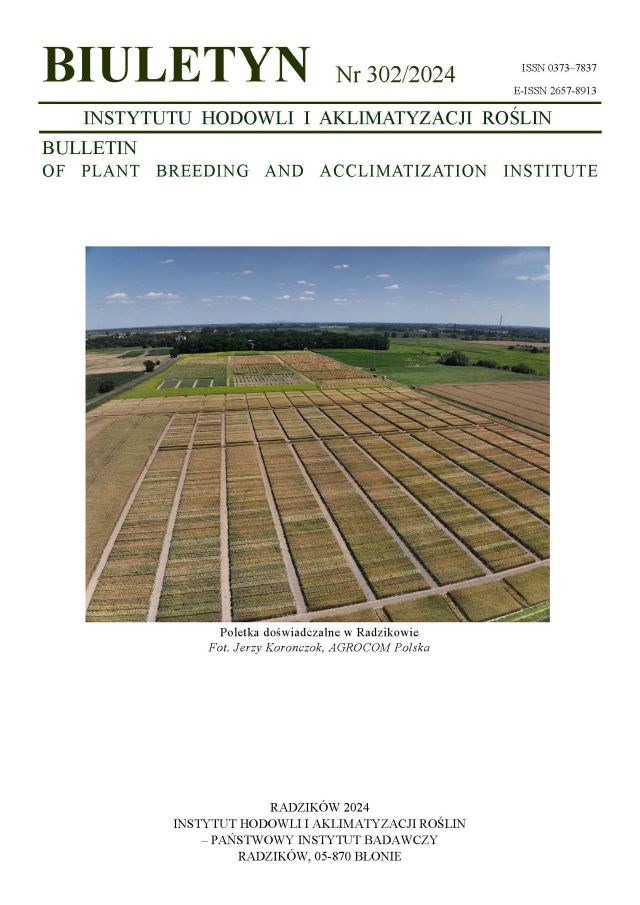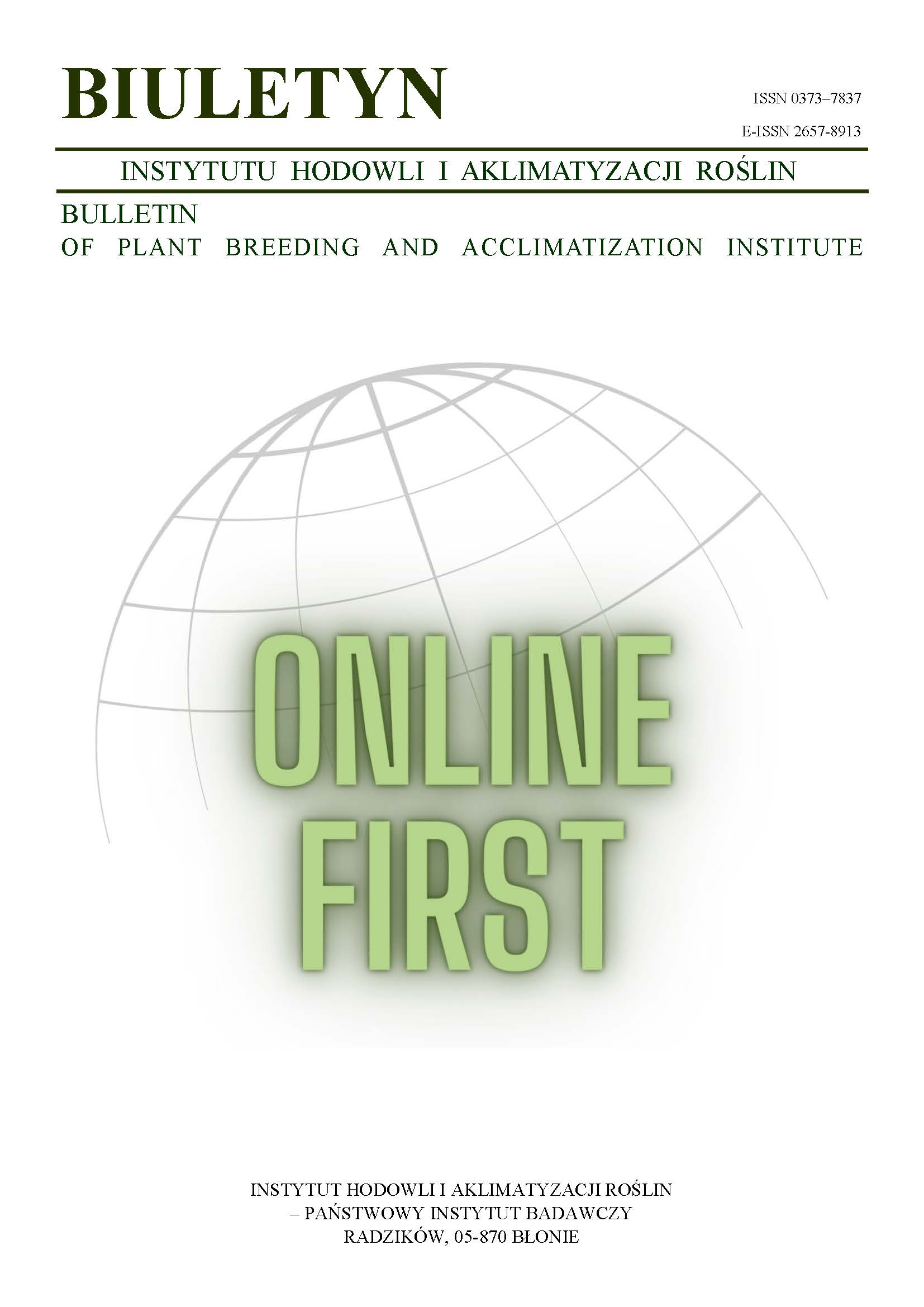Analysis of the lupin (Lupinus angustifolius L.) collection in respect of some morphological and yield structure characters
Renata Galek
kghrin@upwr.edu.plKatedra Hodowli Roślin i Nasiennictwa, Akademia Rolnicza we Wrocławiu (Poland)
Honorata Kalińska
Katedra Hodowli Roślin i Nasiennictwa, Akademia Rolnicza we Wrocławiu (Poland)
Ewa Sawicka-Sienkiewicz
Katedra Hodowli Roślin i Nasiennictwa, Akademia Rolnicza we Wrocławiu (Poland)
Abstract
Investigation covered 15 breeding lines and varieties of Lupinus angustifolius, 7 of which belonging to the group of the “epigonal” determinated type of growth (LAE-1, LAE-2, R/24/99, R 108/99, R 170, Sonet, Wersal) and 8 characterized by the “traditional”, non-determinate type of growth (LAG-24, Ród 451, Boruta, Baron, Elff, Mulat, Zeus, Graf). Field experiments were established in 2003 and 2004 by the randomized blocks method in 3 replications. The following characters of the main stem and lateral branches were evaluated: length of inflorescence (cm), number of flowers, and number of pods. Fertility index (%) was calculated as a ratio of the number of pods harvested to the number of developed flowers. Also, the weight of seeds per plant (g) and the weight of 1000 seeds (g) were analyzed. Variance analysis revealed significant differentiation in all characters studied. The variety Boruta developed the longest inflorescence (25 cm), but the longest (8 cm) inflorescence on lateral branches appeared in the variety Baron. The highest number of flowers in the main stem inflorescence is yielded by the varieties Boruta and Sonet and the breeding line LAE-1, whereas the variety Zeus formed only 17 flowers. The number of flowers on lateral branches differed considerably: the variety Graf and the variety Baron showed the lowest (6) and the highest (10) values respectively. The determinate genotypes: LAE-2-2 and Wersal, as well as the traditional LAG-24, showed the most suitable fertility index for the main stem. The breeding line LAG-24 was distinguishable by a high value of the weight of 1000 seeds (180 g), but this line and also Ród 451 had the lowest weight of seeds per plant (14–15 g).
Keywords:
Lupinus angustifolius, lupin, cultivars, breeding lines, morphological traits, yield structure charactersReferences
Bieniaszewski T., Fordoński G., Lahuta L., Krzebietke S., Żarczyński P. 2003. Wpływ poziomu wilgotności gleby na wzrost i plonowanie tradycyjnych i samokończących form łubinu żółtego. ZPPNR z. 495: 95 — 119.
Google Scholar
Borowska M., Prusiński J. 2003. Zastosowanie auksyny i ekolistu w uprawie łubinu białego. Streszczenia, Międzynarodowa Konferencja „Łubin — wysokobiałkowa roślina XXI wieku”. Kudowa Zdrój, 22–25 września 2003: 11.
Google Scholar
Galek R., Sawicka-Sienkiewicz E., Stawiński St., Kalińska H., Maniukiewicz P. 2004. Wstępna ocena płodności wybranych odmian i rodów Lupinus angustifolius. Genetyka w ulepszaniu roślin uprawnych, pod redakcją P. Krajewskiego, Z. Zwierzykowskiego, P. Kachlickiego, Rozprawy i Monografie Nr 11, IGR PAN w Poznaniu, 2004: 395 — 402.
Google Scholar
Kotecki A., Jasińska Z. 1999. Szczegółowa uprawa roślin. Praca zbiorowa pod redakcją Z. Jasińskiej i A Koteckiego. T. 2. Wydawnictwo Akademii Rolniczej we Wrocławiu.
Google Scholar
Mackiewicz H. 1958. Żywotność pyłku u trzech gatunków łubinów. Roczniki Nauk Rolniczych. T. 79 — A — 1:103 — 110.
Google Scholar
NijakiT., Nijaki J., Czerwińska A. 1999. Postęp w hodowli łubinu żółtego i wąskolistnego: Proceedings of the International Conference „Lupin in Polish and European Agriculture” Przysiek 2–3 September, Poland. (eds) J. Prusiński: 153 — 158.
Google Scholar
Pate J. S., Emery R. J. N, Atkins C. A. 1998.Transport, physiology and partitioning. In: Lupin as crop plants. Biology, production and utilization. (eds) J.S. Gladstones, C.A. Atkins J. Hamblin CAB International: 181 — 226.
Google Scholar
Podsiadło C., Karczmarczyk S. 2002. Ocena wpływu deszczowania i nawożenia mineralnego na plonowanie i zachwaszczenie łubinu wąskolistnego. ZPPNR z. 495:191 — 200.
Google Scholar
Prusiński J., Borowska M. 2002. Potencjał biologiczny roślin strączkowych i jego wykorzystanie cz. I. Zastosowanie regulatorów wzrostu w uprawie roślin strączkowych. Hodowla Roślin i Nasiennictwo 2/2002: 16 — 25.
Google Scholar
Prusiński J., Borowska M. 2003. Potencjał biologiczny roślin strączkowych i jego wykorzystanie cz. II. Dolistne dokarmianie roślin strączkowych. Hodowla Roślin i Nasiennictwo 1/2003: 8 — 13.
Google Scholar
Sienkiewicz S., Żarczyński P., Wierzbowska J., Krzebietke S. 2003. Wpływ nawożenia makroskładnikami na plony nasion, białka i tłuszczu oraz niektóre cechy morfologiczne dwóch odmian łubinu białego. ZPPNR z. 495: 231 — 236.
Google Scholar
Święcicki W., Święcicki W.K., Wiatr K. 1997. Historia, współczesne osiągnięcia i perspektywy hodowli roślin strączkowych w Polsce. ZPPNR 446: 15 — 32.
Google Scholar
www.hrsmolice.republika.pl
Google Scholar
Authors
Renata Galekkghrin@upwr.edu.pl
Katedra Hodowli Roślin i Nasiennictwa, Akademia Rolnicza we Wrocławiu Poland
Authors
Honorata KalińskaKatedra Hodowli Roślin i Nasiennictwa, Akademia Rolnicza we Wrocławiu Poland
Authors
Ewa Sawicka-SienkiewiczKatedra Hodowli Roślin i Nasiennictwa, Akademia Rolnicza we Wrocławiu Poland
Statistics
Abstract views: 59PDF downloads: 35
License
Copyright (c) 2006 Renata Galek, Honorata Kalińska, Ewa Sawicka-Sienkiewicz

This work is licensed under a Creative Commons Attribution-ShareAlike 4.0 International License.
Upon submitting the article, the Authors grant the Publisher a non-exclusive and free license to use the article for an indefinite period of time throughout the world in the following fields of use:
- Production and reproduction of copies of the article using a specific technique, including printing and digital technology.
- Placing on the market, lending or renting the original or copies of the article.
- Public performance, exhibition, display, reproduction, broadcasting and re-broadcasting, as well as making the article publicly available in such a way that everyone can access it at a place and time of their choice.
- Including the article in a collective work.
- Uploading an article in electronic form to electronic platforms or otherwise introducing an article in electronic form to the Internet or other network.
- Dissemination of the article in electronic form on the Internet or other network, in collective work as well as independently.
- Making the article available in an electronic version in such a way that everyone can access it at a place and time of their choice, in particular via the Internet.
Authors by sending a request for publication:
- They consent to the publication of the article in the journal,
- They agree to give the publication a DOI (Digital Object Identifier),
- They undertake to comply with the publishing house's code of ethics in accordance with the guidelines of the Committee on Publication Ethics (COPE), (http://ihar.edu.pl/biblioteka_i_wydawnictwa.php),
- They consent to the articles being made available in electronic form under the CC BY-SA 4.0 license, in open access,
- They agree to send article metadata to commercial and non-commercial journal indexing databases.
Most read articles by the same author(s)
- Agnieszka Stępień, Tadeusz Drzazga, Renata Galek, Dariusz Zalewski, Ada Biela, Bartosz Kozak, The comparison of Mexican genotypes and Polish varieties of spring wheat regarding the major yielding traits , Bulletin of Plant Breeding and Acclimatization Institute: No. 281 (2017): Regular issue
- Renata Galek , Bartosz Kozak , Dariusz Zalewski , Ewa Sawicka-Sienkiewicz , Adela Adamus , Agnieszka Kiełkowska , Research on gametic embryogenesis in Lupinus angustifolius L. — haploid induction and analysis of the genetic basis of this process , Bulletin of Plant Breeding and Acclimatization Institute: No. 286 (2019): Special issue
- Renata Galek, Henryk Bujak, Analysis of similarity of spring rye forms in regard to some agronomy characters , Bulletin of Plant Breeding and Acclimatization Institute: No. 231 (2004): Regular issue
- Ewa Sawicka-Sienkiewicz, Renata Galek, Dariusz Zalewski, Jolanta Augiewicz, Comparison of interspecific hybrids Lupinus albus (sensu lato) × Lupinus mutabilis in respect of some quantitative characters , Bulletin of Plant Breeding and Acclimatization Institute: No. 240/241 (2006): Regular issue
- Renata Galek, Dariusz Zalewski, Jolanta Augiewicz, Ewa Sawicka-Sienkiewicz, Comparative evaluation of intraspecific hybrids of Lupinus mutabilis in the F3 and F4 generations with regard to some quantitative characters , Bulletin of Plant Breeding and Acclimatization Institute: No. 240/241 (2006): Regular issue
- Ewa Sawicka-Sienkiewicz, Renata Galek, Elements of seed yield structure and selected morphological characters of mutants of Andean lupin (L. mutabilis Sweet) in the year 2001 , Bulletin of Plant Breeding and Acclimatization Institute: No. 226/227 (2003): Regular issue
- Renata Galek, Analysis of variation of yield structure traits in spring rye collection , Bulletin of Plant Breeding and Acclimatization Institute: No. 226/227 (2003): Regular issue














